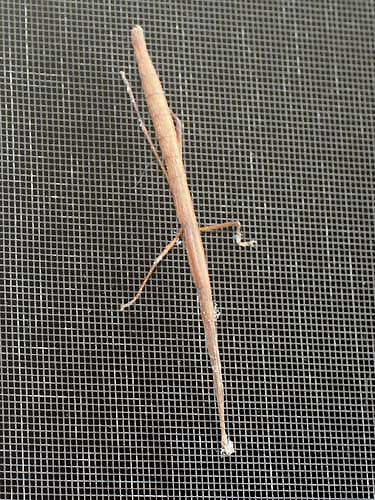
Stick Bug
It is real, but the stick bug in Pan’s Labyrinth is magical.

I’m not keen on soft bodied critters. When I was a kid living near the Scioto River it was not uncommon for snakes to take up residence around our house. Alligator lizards often live in my gardens. The first sighting gives me a fright, until I know to expect them. There is a great fact sheet that I plan to read for future lizard encounters.

This image is from the San Diego Zoo website.
When I found tadpoles in a concrete drainage ditch that was very nearly dry, I debated about taking on the responsibility of their care. Before I could decide, my husband had scooped them up and put them a large plastic tray in the courtyard.
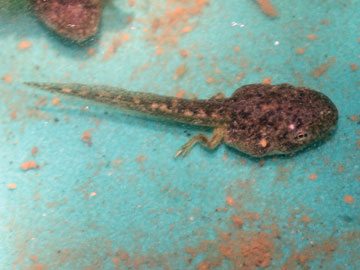
Tadpole in New Digs
The green goop was scooped up with them from the drainage ditch.
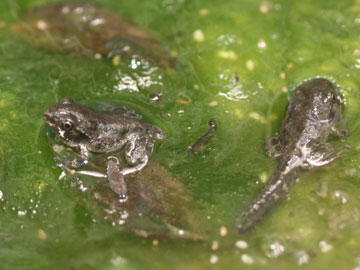
Transition
When some of the tadpoles evolved to having legs and shortened tails we placed a couple of rocks in their container. Eventually they were moved to a different container with less water.
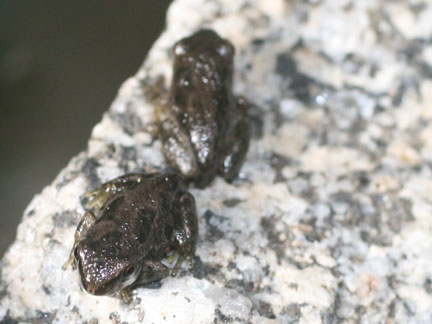
Legs and Shortened Tails
This is the first little one to leave the container. Notice the color change.

Perched
I didn’t want to touch or scare him, so I moved my to-be-planted 6-pack of alyssum to within hopping distance. He hopped right in and eventually was followed by several other little guys.
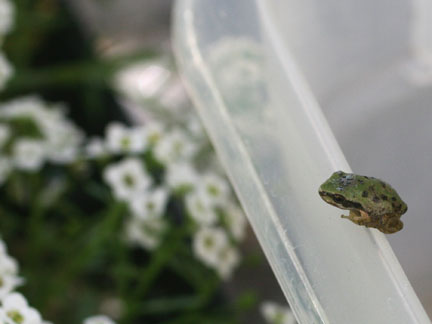
First to Leave
What I Learned–
Before you take on the responsibility for other living creatures find out everything you can. Your good intentions should not cause harm.
A few sites I visited–
Virus Which Causes Sudden Death and Deformities
Identifying California Frogs and Toads
Raising Tadpoles through Adulthood
I suspected that at some point, I would create the perfect environment for some type of insect. When you have loads of dried plant materials and fiber it is rather likely some critters will move in.
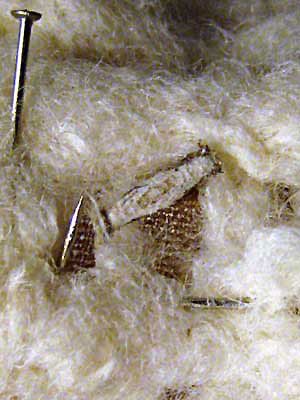
This is a detail of a work in progress. It would have been a cup made of wool and rayon that I just couldn’t manage to finish. The head of a straight pin is in the upper left of the photo, and the tip of a pin is next to the casemaking moth.
How Did I Find Moths?
I read an article that stated empty birds’ nests should be removed from around your house because casemaking moths might take up residence. I had a collection of nests containing little vignettes in my studio. When I checked them, I found casemaking moths. After the shock wore off, and the sinking feeling that everything in my studio might be destroyed; I methodically started the hunt for the critters. I discarded materials and several works in progress.
I did a test to see if I can save a piece if it is found to have moths. I soaked some works in progress that had been attacked by moths in vinegar for a couple of days, rinsed in water, and laid them in the sun. My hope is that if there were eggs, they were killed.
The vinegar soaking changed the appearance of the pieces. I bind fiber onto washers for use as coding components. The bottom row was soaked in vinegar. The washers are not the same type, but they have a similar composition. The fiber is wool that sustained a color change due to the oxidation of the metal. The change in color of the cream wool is not to my liking, so the solution would be to age the washers, then bind them.

If the same or similar result occurs the next time I use a vinegar bath, I’m pretty sure that I will use the technique in the future to age some pieces. It is simple and non-toxic.
I found the casemaker moths–
Some insects are attracted to a particular color, fragrance or pheromone, or a location. I did not find a pattern or consistency in where they made their homes.
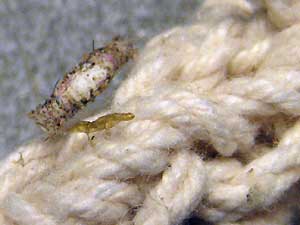
And it does not seem to matter if the fiber was impregnated with wax or shellac. It may be too early to tell, but I do not think that they took up residence in or on any of my work that was treated with salt.
This is the edge of a piece of foam core that I used for a photo set-up.
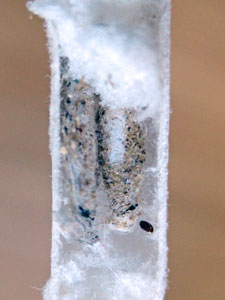
For More Information From Reliable Sources–
Casemaking Clothes Moth AgriLife Extension Texas A&M
Clothes Moths by Mike Potter, Extension Entomologist, University of Kentucky, College of Agriculture
Clothes Moths University of California Agriculture & Natural Resources, Statewide Integrated Pest Management Program
I remember seeing a television program about the Wieliczka Salt Mine on PBS, TLC, or the History Channel. So, when I received an email with images of the mine I was delighted.

Then a very cool thing happened. The attached link took me to the UNESCO World Heritage site which has loads of amazing information and images of places of cultural importance categorized by country.
I plan to spend some time on the site in the near future.
Early on in my education at Ohio State University, I became aware of artists who would go to a site and use the materials present on that site to make a work. Often the work appeared as though it occurred naturally.
I had a romantic notion of visiting the woods near my parents’ home, connect with the site, and make a work. When I attempted it, I realized right off that I wasn’t alone. There were snakes, mosquitos, and ticks, all of which creeped me out.
I recently read about Stuart Wood’s environmental work on the Studio ‘g’ blog. The images of his scorched patterns on trees gave me pause. I like the idea of using a scorching process to alter a material. And that controlling a potentially destructive process can result in something beautiful.
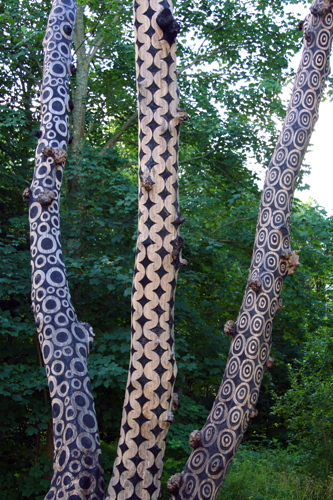
When I visited Stuart Wood’s website I found many gorgeous pieces. And I admit that I found myself saying out loud, “…really, seagull feathers.”
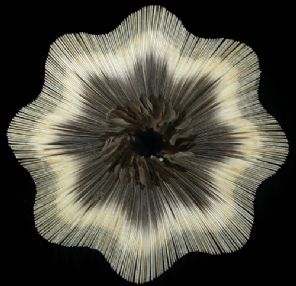
I often use dried plant parts in my work. Typically the plants must have some interesting tactile quality, be toxic, and have a cultural myth or superstition. I was looking through a stash of dried plant parts and found some Haworthia limifolia leaves. They have great texture with sharp and pointy tips.
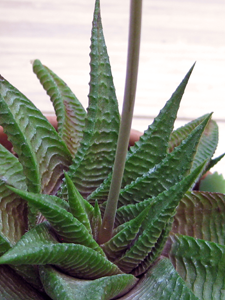
I googled Haworthia limifolia looking for information. I was a bit disappointed that the plant isn’t toxic. Apparently it is often used in place of Aloe for skin ailments. I did find a line that popped up in several articles, “Haworthia limifolia is often used by traditional healers as a spiritual remedy to ward off evil.” Curious. What kind of evil?
I have a contact at the UC Botanical Garden so I sent him an email inquiry about the plant. The plant is one that he gave to me several years back. He sent me a pdf of an article that I hadn’t read, Lightning Birds and Thunder Trees authored by Adrian Koopman. The article states that Haworthia is used as a charm to protect against lightning.
We don’t see much in the way of lightning where I live. Before reading about the plant’s reference to lightning, I had already bound the bits to a piece of hardware cloth to become part of a lid. My work must have the appearance of a life lived, so I age the work using one or more techniques–wax, heat, fire, salt, molten sugar, chemicals… and sometimes I bury the work.
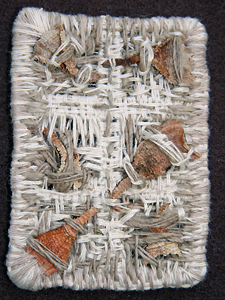
The Haworthia bits are bound to the hardware cloth with cotton and bamboo fiber which works great with all of the techniques.
A few lightning information links–
S.A. Weather and Disaster Information Service, South Africa
Global Hydrology and Climate Center
Mortality Statistics–Victim of lightning by country
NOAA National Severe Storms Laboratory